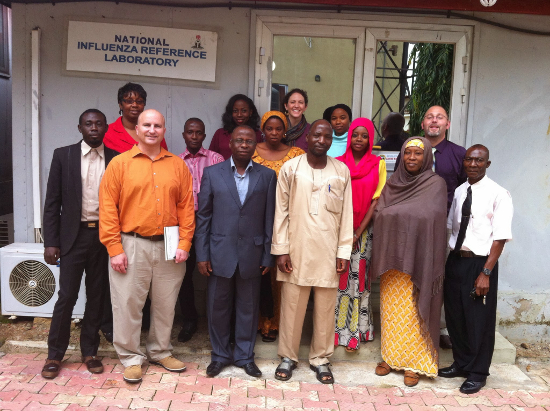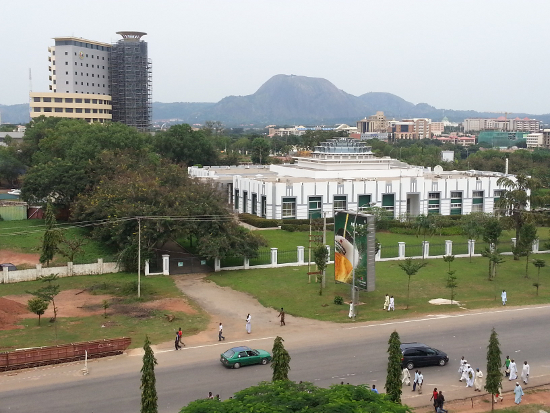
| Dec. 2013 | |||||||||||
| Top stories | |||||||||||
| In the news | |||||||||||
| Photos | |||||||||||
| Contact us | |||||||||||
| Archive | |||||||||||
|
Microbiologist has ‘Experience of a lifetime’ |
by Cindy Hadish
Civil unrest in Nigeria did not detract from the public health mission that took microbiologist Jeff Benfer to West Africa in September.
In fact, one of the memories that sticks with Benfer, supervisor of virology and molecular biology, is the friendliness of the people he encountered.
"Their standard greeting was 'You're welcome,'" said Benfer, which was perplexing until he realized the locals were welcoming the group to their country. "They'd say 'You're welcome,' all the time with a smile on their face."
 Jeff Benfer (far left, front row) poses with the staff from the
National Influenza Reference Laboratory in Abuja, Nigeria.
Jeff Benfer (far left, front row) poses with the staff from the
National Influenza Reference Laboratory in Abuja, Nigeria.Benfer went on the trip as one of two representatives of the Association of Public Health Laboratories, along with two others from the CDC.
The International Influenza Laboratory Assessment's mission is to develop and enhance laboratory capacity for seasonal and pandemic influenza surveillance. The CDC Influenza Division provides funding for the work in more than 40 countries that request laboratory assessments.
Benfer's role, like that of an APHL representative from New York, was to provide an assessment of the National Influenza Reference Laboratory facility in Abuja, the capital city of Nigeria.
The two also provided training on techniques and best practices for influenza surveillance for about a dozen lab workers, epidemiologists and program administrators.
It was Benfer's first trip, while his counterpart from New York had previous experience.
"I was a trainer, but I was also essentially being trained on the assessment process at the same time," he said.
Although they didn't know all of the best practices that are followed in the United States, Benfer called the laboratory staff in Abuja a well-educated and effective group.
"The people in the lab were highly skilled and highly knowledgeable," he said. "And they actually had really good equipment. What they lacked was a good facility."
During the weeklong stay, the group looked at two sites where the laboratory might be relocated. The current facility is housed in a somewhat decrepit building, with floor boards cracked from the region's high humidity.
The buildings they toured had concrete floors and solid walls that could hold up to the weather and would offer a better floor plan, he said.
 The view from Benfer's hotel room includes the Aso Rock, a
geographic icon of the city of Abuja.
The view from Benfer's hotel room includes the Aso Rock, a
geographic icon of the city of Abuja. They also provided training on a new automated instrument used to extract RNA to test for the presence of the influenza virus. The robotic system will make testing easier, with a more consistent quality, he noted.
While the lab had been given the equipment previously, there were no company representatives to provide training, so it sat unused.
"It was incredibly gratifying," Benfer said. "It was nice to help a lab in a developing country that doesn't have access to the tools we have here, that people can take for granted."
Located in the center of Nigeria, Abuja is fairly new, replacing Lagos — the country's most populous city — as the capital in 1991.
Abuja's metropolitan area has a population estimated at 3 million people. The central site was chosen as the capital in a token of neutrality, given Nigeria's ethnic and religious divisions.
Benfer said the public health group was driven from the airport in a bulletproof, armored vehicle and saw “assault rifles on every corner."
One planned tour of a hospital was derailed after a shootout between a terrorist group and the secret service sent numerous victims to that hospital.
Despite some trepidation, Benfer said he and the other Americans did not feel at risk and were able to experience local restaurants and a market where he purchased two handcrafted wooden masks, a traditional African dress for his wife and an oil painting of a lion by a local artist.
"I'm glad I went," Benfer said, adding that despite the grueling 24-hour journey, he would not hesitate to go on another trip. "It was an experience of a lifetime, for sure."